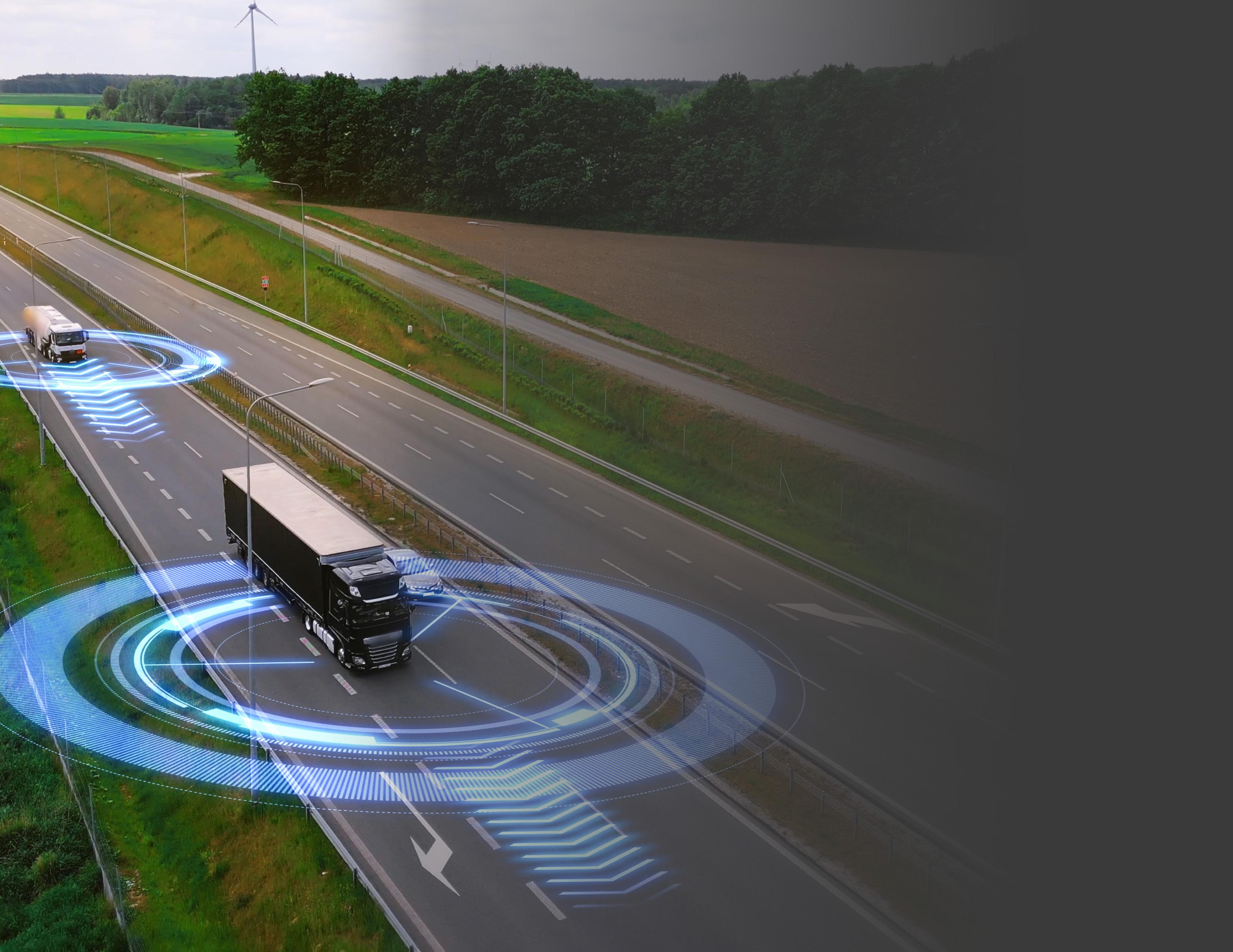

Your Transportation Management Solution Buyer’s Guide
Driving Better Results With Technology
Table of Contents
› Your Transportation Transformation Preparation Checklist
› General Transportation Software Buying Tips
› Transportation Management System (TMS)
› Route Optimization Software
› Route Execution Software
› Electronic Proof of Delivery
› Home Delivery
› Choosing the Right Technology Partner
› Best Practices for Maximizing ROI
› Your Partner in Next-Generation Transportation Technology

About This Guide
The future of the transportation and logistics industry is coming toward us, and fast. Just as the horizon rushes up to meet you as you travel down a straightaway, a better way of doing business is arriving imminently, and this new paradigm will be defined by advanced, next-generation technology.
Transportation software isn’t a novel concept, of course, but with the solutions on the market today offering significant advantages over the increasingly tough competition, the need for it is greater than ever before. In other words, it’s a good time to consider tuning up your organization’s technology stack.
An experienced logistics leader like yourself knows that the first step in this process is getting educated about the kinds of systems available and the various applications of each. That’s where this buyer’s guide comes in—we’re here to walk you through the ins and outs of each, as well as how you can identify the best options for your company’s needs.
Ready to take the wheel and get up to speed? By the time you’re done reading, you’ll be set to hit the road on your digital transformation journey.

Your Transportation Transformation Preparation Checklist
1. Identify the operational challenges you want to solve —Document where and how your current processes and solutions fall short so that you can determine what solutions will be most impactful for your business.
2. Set measurable goals and establish your ideal end state —Be specific about what success looks like, including KPIs, service level improvements, or cost savings that you expect the project to deliver.
3. Establish a realistic timeline —Account for research, internal alignment, vendor selection, implementation, testing and change management (and don’t rush or skip any phases).
4. Audit your current tech stack and data readiness— Understand what systems you already have; where gaps and/or overlaps exist; and whether your data is clean, centralized and import-ready.
5. Secure executive sponsorship and cross-functional buy-in—Strong support from leadership helps to ensure the initiative is properly funded, and the cooperation of all departments is vital.
Don’t rush into software selection and implementation without making these considerations—you’ll set the project back before it’s even begun.
General Transportation Software Buying Tips
Before we get into the specifics of the different solutions we’ll cover, it’s a good idea to first take a look at some general best practices for buying enterprise technology:
1. Favor solutions that can be deployed via the cloud—Cloud-based systems offer faster implementation, easier scaling, automatic updates and lower up-front costs than on-premise solutions.
2. Look for built-in artificial intelligence (AI) functionality—Ensure that any solution you consider has AI embedded at its core. The future of business software will be shaped by this technology.
3. Know the value of integration and configurability—Choose software that can connect seamlessly with the rest of your tech stack, and understand the importance of flexibility to fit your workflows.
4. Prioritize the user experience—A clean, intuitive interface can shorten training time, improve user adoption and reduce costly errors, especially for frontline and mobile users.
5. Don’t forget about analytics and reporting—Look for systems that offer built-in dashboards, business intelligence (BI) integration and key performance indicator (KPI) monitoring.
You’ll also want to thoroughly evaluate your vendor for its industry focus, company culture, development approach and brand reputation. We’ll discuss choosing your technology partner in more detail later in this guide.

Transportation Management System (TMS)
Designed to facilitate shipping and logistics, TMS solutions streamline end-to-end transportation operations.
How Do I Know My Business Needs a TMS?
» You manage a high volume of shipments across multiple carriers or modes.
» Freight costs are unpredictable and/or rising faster than expected.
» Manual shipping processes are causing delays and/ or errors.
» You’re struggling to meet customer delivery expectations reliably.
» Your team spends too much time compiling reports and managing exceptions.
Signs It’s Time To Replace Your Old TMS
» Your system lacks integration with ERP, WMS or carrier portals.
» You can’t handle multi-leg or multi-modal shipments efficiently.
» The user interface is outdated or difficult for new users to learn.
» You don’t have real-time visibility into freight status or exceptions.
» You’ve outgrown the system’s capacity or configuration flexibility.
Must-Have TMS Features
» Carrier rate shopping and automated carrier selection
» Real-time shipment tracking and exception alerts
» Freight audit-and-pay capabilities
» Integration with ERP, WMS and other systems
» Advanced reporting and key performance indicator (KPI) dashboards
Key TMS Benefits
» Reduced transportation costs
» Increased visibility and control of supply chain operations
» Faster, more reliable deliveries
» Fewer manual touchpoints and errors
» Improved scalability as your business grows

Aptean TMS : Built for Shippers, Powered by Intelligence
Aptean TMS gives manufacturers, distributors and retailers the control and visibility they need across all modes and methods of transportation. Whether you’re moving freight by truckload, less-than-truckload, parcel, rail, sea or international lanes, the system makes it simple to optimize planning, execution and cost control—all from a single platform.
Smart dock management tools help streamline inbound and outbound activity to reduce bottlenecks and improve on-time performance. The solution also includes enhanced freight audit-and-pay functionality to help you catch errors, enforce contracts and simplify reconciliation. And with built-in carrier and vendor portals, you can improve collaboration across your transportation network and reduce manual communication.
What’s more, Aptean TMS includes an AI-powered 3D load builder that makes the most of every trailer, pallet or container. This powerful feature automatically generates optimized load plans based on real-world dimensions and constraints—saving time and reducing the risk of damage.
In short, our solution is everything modern shippers need to take control and scale smarter.
Route Optimization Software
Purpose-built for planning the most efficient routes possible, this software also offers strategic route planning for continuous improvement.
How Do I Know My Business Needs Route Optimization Software?
» Planning daily or weekly routes consumes hours of manual effort.
» Fuel and labor costs are increasing, eating into profit margins.
» You want to support more deliveries per day without adding vehicles.
» Delivery time windows are difficult to meet consistently.
» Your routes don’t reflect vehicle capacity and/or driver availability.
Signs It’s Time To Replace Your Old Route Optimization Software
» You’re still building routes manually or in spreadsheets.
» Your current solution doesn’t factor in delivery windows or driver shifts.
» Changes to routes take too long to implement or communicate.
» You can’t model “what-if” scenarios for future planning.
» You’re unable to push your plans to dispatch and/or driver systems.
Must-Have Route Optimization Software Features
» Real-time and historical traffic data integration
» Dynamic daily route planning and long-term strategic modeling
» Optimization engine that accounts for realworld constraints
» Scenario planning tools for network redesign
» Integration with dispatch, execution and telematics platforms
Key
Route
Optimization Software Benefits
» Fewer miles driven and reduced fuel consumption
» Increased delivery capacity with existing resources
» Reduced planning time and fewer planning errors
» Higher on-time, in-full (OTIF) delivery rates
» Lower logistics costs and greater profitability

Aptean Routing & Scheduling: Cloud-Native Route Optimization with AI Intelligence
Aptean Routing & Scheduling is the next generation of the trusted Paragon software—now delivered through Aptean AppCentral, our cloud-native enterprise platform. The system uses powerful optimization algorithms to generate efficient routes in minutes, while built-in AI tools take planning to the next level. An AI route planning assistant not only suggests improvements, but also learns from the manual adjustments planners make based on real-world knowledge, improving future results automatically.
With the rolling schedule functionality, you can visualize every route—completed, in progress and scheduled—and make adjustments on the fly as conditions change. Meanwhile, intelligent AI agents flag performance variances to highlight areas for improvement, giving your team actionable insights to continuously refine operations.
For longer-term planning, strategic scenario modeling allows you to simulate changes such as adding depots, flexing driver shifts or adjusting delivery frequencies before committing to them. And with the territory optimizer, you can automatically redraw service zones to improve stop density, reduce mileage and ensure consistent service across your customer base.
This smart, connected solution brings together efficiency and intelligence, helping you cut fleet costs by up to 30%, increase on-time delivery and give both planners and drivers the tools they need to perform at their best.
Route Execution Software
With real-time tracking via telematics integration and route management capabilities, route execution solutions help you make the most of your optimized plans.
How Do I Know My Business Needs Route Execution Software?
» Dispatchers and planners lack real-time visibility into vehicle movements.
» Routes are not always carried out according to plan.
» Your team struggles to proactively manage route changes throughout the day.
» Driver performance varies widely and/or is difficult to measure.
» You can’t effectively manage multi-trip routes in real time.
Signs It’s Time To Replace Your Old Route Execution Software
» Your system doesn’t integrate with GPS, telematics or mobile apps.
» Route updates don’t flow back to dispatch or customer service in real time.
» It’s difficult for you to verify whether planned vs. actual routes were followed.
» Your current solution can’t handle live traffic data or route deviations.
» Your planning process doesn’t account for drivers’ actual hours worked.
Must-Have Route Execution Software Features
» Real-time route tracking with GPS/telematics integration
» Alerts for route deviations, delays or missed stops
» Live management module for dispatchers and drivers
» Automatic planned vs actual route analysis
» Driver instructions delivered via satellite navigation devices
Key Route Execution Software Benefits
» Increased agility to respond to exceptions
» Reduced late deliveries and route deviations
» Better alignment between planning and execution
» Enhanced driver accountability and safety
» Continuous route planning improvement with real-world data

Aptean
Route Execution: Real-Time Visibility and Control in the Field
As a powerful add-on to Aptean Routing & Scheduling, Aptean Route Execution is much more than just an extra module. This software takes your delivery operations beyond planning and into the real world—bridging the gap between strategy and execution. The real-time insight our solution provides enables businesses to monitor performance, respond to issues and continuously improve.
At the core is the route execution module, which tracks delivery progress against plan, comparing planned versus actual performance. This real-time data flows back into your planning engine to refine future routes and boost on-time delivery rate. Meanwhile, the live management module gives your team a control tower view, highlighting KPIs and deploying alerts so you can reverse negative trends and proactively address pain points.
Additional features include waypoint mapping, which offers turn-by-turn guidance according to the planned route; and dynamic tripping, which supports multi-trip operations by automatically recalculating routes as drivers return to the depot and reload.
Altogether, Aptean Route Execution equips logistics teams with the visibility, tools and agility needed to deliver on time, every time—even in the face of changing conditions.
Electronic Proof of Delivery (ePOD)
By digitizing driver tasks and keeping customers updated during the delivery process, ePOD software facilitates
final mile processes.
How Do I Know My Business Needs ePOD Software?
» You’re still relying on paper delivery documents or signatures.
» There are often disputes over delivery time, condition or location.
» Customer satisfaction drops due to a lack of proactive communication.
» It’s difficult to track drivers’ meal and rest stops in the field.
» You lack visibility into KPIs and trends that could inform decisions.
Signs It’s Time To Replace Your Old ePOD Software
» Your ePOD system doesn’t support mobile capture or digital signatures.
» Delivery information isn’t available to customers in real time.
» Drivers can’t easily update delivery status or complete tasks digitally.
» Data entry errors are common when transferring paper notes.
» You’re unable to capture documentation of delivery exceptions.
Must-Have ePOD Software Features
» Digital signature capture and photo documentation
» Automated customer notifications
» Real-time data synchronization with backend systems
» Mobile app for drivers with offline functionality
» Timestamp and geolocation for each delivery
Key ePOD Software Benefits
» Faster, more accurate proof of delivery processes
» Fewer customer disputes and support calls
» Better documentation for delivery issue resolution
» Improved driver efficiency and accountability
» Seamless visibility for internal teams and customers

Aptean Proof of Delivery: Streamlining the Final Mile for Better Customer Satisfaction
Aptean Proof of Delivery (ePOD) gives transportation businesses total visibility and control over the final mile.
The browser-based central management console lets dispatchers and supervisors oversee operations in real time— assigning routes, monitoring statuses and verifying receipt of delivery data. On the road, a mobile app for drivers ensures seamless execution in the field, capturing digital signatures, barcode scans, timestamps and even photos to confirm successful delivery.
For customers, a dedicated portal keeps them informed with real-time tracking updates, and automated notifications help ensure first-time delivery success. Meanwhile, customizable electronic forms help your drivers gather required delivery info quickly and accurately, and driver break management allows them to easily log meals and stops.
Aptean ePOD also includes tools to make operations smarter and more adaptable. A flexible reporting dashboard gives your team visibility into performance trends and compliance metrics, while ad-hoc route building and sequencing capabilities make it easy to respond to last-minute delivery requests or reroute based on real-world events.
Together, these features equip your team to execute faster, resolve issues sooner and keep customers happier.
Home Delivery
Made to enhance your omnichannel customer journey, home delivery
solutions allow you to balance choice, convenience and cost-efficiency.
How Do I Know My Business Needs Home Delivery Software?
» You offer home delivery and need to provide flexible scheduling.
» Customer satisfaction is declining due to missed or late deliveries.
» You can’t track or optimize the full delivery journey.
» Rescheduling and communication with customers are mostly manual.
» You want to improve last mile delivery efficiency.
Signs It’s Time To Replace Your Old Home Delivery Software
» Your system can’t present cost-effective delivery windows at point of sale.
» Customer service struggles to provide accurate status updates.
» Your solution can’t integrate with other systems.
» Capacity planning doesn’t account for warehouse or driver constraints.
» You don’t have a self-service portal for customers to manage deliveries.
Must-Have Home Delivery Software Features
» Customer self-service tools for scheduling and tracking
» Automated delivery notifications via SMS and email
» Real-time capacity management and progress monitoring
» Analytics to track first-time delivery success and satisfaction
» Integrated route optimization for last mile efficiency
Key Home Delivery Software Benefits
» Higher customer satisfaction and loyalty through better communication
» Increased first-time delivery success rate
» Lower operational costs from optimized routes and time slots
» Improved visibility across the entire delivery lifecycle
» Greater insight into delivery data for better strategic decision-making

Aptean Home Delivery: Boosting Efficiency and Enhancing the Omnichannel Journey
By providing a comprehensive set of functionalities for home delivery management, Aptean Home Delivery helps businesses streamline complex last-mile operations. The software integrates directly with point-of-sale systems to offer tailored delivery windows at checkout, balancing customer preferences with operational efficiency. Behind the scenes, it builds optimized routes that improve vehicle utilization and increase drops per trip, all while factoring in real-time capacity management to avoid overcommitting.
The platform supports a wide range of fulfillment models, whether you’re delivering from warehouses, stores or third-party partners. As orders are scheduled and dispatched, customers receive automated updates and can track progress in real time, enhancing satisfaction and reducing service calls.
Aptean Home Delivery also builds and maintains a database with the entire lifecycle of every order so that information can be analyzed by BI to create reports and generate valuable insights. And for operations that rely on parcel carriers, the software also includes robust parcel pack and delivery tools that automate packing, label generation and carrier selection.
Whether you manage your own fleet, use third-party couriers or operate a hybrid model, the solution adapts to your business and helps you consistently deliver on your promise to customers.
Choosing the Right Technology Partner
We didn’t cover this in detail before because it deserves a good bit more attention than a single numbered item. Making the best decision for your business in vendor selection is crucial. These steps can serve as the basis for your due diligence:
1. Verify industry expertise—Vendors who specialize in transportation and logistics will understand your pain points, regulations and workflows.
2. Ensure a cultural fit—Look for a vendor whose approach to collaboration, support and communication aligns with your team’s needs and working style.
3. Confirm commitment to innovation—Choose a company that invests in continuous improvement, releases updates regularly and incorporates artificial intelligence (AI).
4. Check for a proven reputation—Check for a strong track record with customers, positive reviews, case studies and third-party recognition from reputable sources.
5. Select a partner with long-term viability—Choose a partner that has a clear product roadmap and the financial stability to grow with your business.
Keep in mind that this process is less about buying a product from a salesperson and more about establishing a long-lasting relationship of trust, support and commitment between two businesses.


Best Practices for Maximizing ROI
Purchasing, implementing and maintaining a new transportation solution—or multiple—requires dedicating time, effort and financial resources, so you should be looking to get a good return on investment (ROI). Here’s how:
1. Invest in user training and adoption—Even the best system can underdeliver if users don’t learn to fully leverage it and use it consistently.
2. Collaborate closely with your provider during implementation—Rely on your vendor’s expertise, and make sure the solution is configured for your workflows.
3. Regularly review performance metrics and workflows—Use your system’s reporting tools to track KPIs and identify areas for savings and/or improvement.
4. Designate internal champions and power users Empower tech-savvy team members to become go-to experts that drive adoption and help others troubleshoot.
5. Stay current with updates and new features—Stay on the latest version of your software to take advantage of enhancements, especially those related to automation and AI.
Make the most of your new technology by following these recommendations, evaluating your progress frequently and fine-tuning your approach based on desired results.
Your Partner in Next-Generation Transportation Technology
Why should you choose Aptean as your technology provider? We’ve got a few compelling reasons to share.
First, our team has decades of combined hands-on experience in transportation and logistics. What’s more, you can trust every Aptean solution to be backed by support from dedicated experts that you can count on. And our track record speaks for itself— Supply & Demand Chain Executive recognized us with its 2024 Top Software & Technology Solutions award, and most recently we were named a Market Leader for Route Planning Software by Featured Customers.
We also take pride in leading the way with innovation. Every one of our solutions is cloud-native and built to scale, and our TMS, route optimization software and proof of delivery solution are now on Aptean AppCentral, our all-in-one AI-powered platform. It connects all of your Aptean systems with unified datalake, automates key workflows to streamline operations and introduces powerful tools like GenAI Query, a conversational chatbot that makes it easy to access valuable insights.
With us, you’ll have access to a full suite of transportation solutions, including every solution type covered in this guide. That makes us a “one-stop shop” for your technology needs, so there’s no hassle of working with multiple vendors. And because each system is designed to work seamlessly with the others, your team can save time on data re-entry and other tedious manual tasks.
Finally, we take a hands-on, collaborative approach to implementation. Our team works closely with yours to create a realistic timeline with milestones, configure the solution around your company’s unique needs and provide best practice advice throughout the rollout. It’s all part of our commitment to helping you achieve your goals—and to making sure your investment delivers value as soon as you hit the road.

Contact us at info@aptean.com or visit www.aptean.com/en-US/solutions/tms

About Aptean
Aptean is one of the world’s leading providers of purpose-built, industry-specific software that helps manufacturers and distributors effectively run and grow their businesses. With both cloud and on-premise deployment options, Aptean’s products, services and unmatched expertise help businesses of all sizes to be Ready for What’s Next, Now®. Aptean is headquartered in Alpharetta, Georgia and has offices in North America, Europe and Asia-Pacific.
To learn more about Aptean and the markets we serve, visit www.aptean.com.
